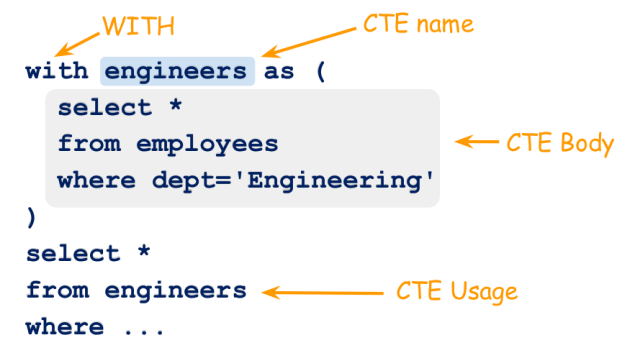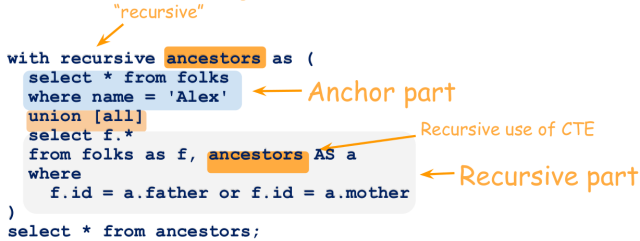MySQL · 特性分析 · common table expression
Author: 张远
common table expression
Common table expression简称CTE,由SQL:1999标准引入, 目前支持CTE的数据库有Teradata, DB2, Firebird, Microsoft SQL Server, Oracle (with recursion since 11g release 2), PostgreSQL (since 8.4), MariaDB (since 10.2), SQLite (since 3.8.3), HyperSQL and H2 (experimental), MySQL8.0.
CTE的语法如下:
WITH [RECURSIVE] with_query [, ...]
SELECT...
with_query:
query_name [ (column_name [,...]) ] AS (SELECT ...)
以下图示来自MariaDB
Non-recursive CTEs

Recursive CTEs

CTE的使用
- CTE使语句更加简洁
例如以下两个语句表达的是同一语义,使用CTE比未使用CTE的嵌套查询更简洁明了。
1) 使用嵌套子查询
SELECT MAX(txt), MIN(txt)
FROM
(
SELECT concat(cte2.txt, cte3.txt) as txt
FROM
(
SELECT CONCAT(cte1.txt,'is a ') as txt
FROM
(
SELECT 'This ' as txt
) as cte1
) as cte2,
(
SELECT 'nice query' as txt
UNION
SELECT 'query that rocks'
UNION
SELECT 'query'
) as cte3
) as cte4;
2) 使用CTE
WITH cte1(txt) AS (SELECT "This "),
cte2(txt) AS (SELECT CONCAT(cte1.txt,"is a ") FROM cte1),
cte3(txt) AS (SELECT "nice query" UNION
SELECT "query that rocks" UNION
SELECT "query"),
cte4(txt) AS (SELECT concat(cte2.txt, cte3.txt) FROM cte2, cte3)
SELECT MAX(txt), MIN(txt) FROM cte4;
- CTE 可以进行树形查询
 初始化这颗树
初始化这颗树
create table t1(id int, value char(10), parent_id int);
insert into t1 values(1, 'A', NULL);
insert into t1 values(2, 'B', 1);
insert into t1 values(3, 'C', 1);
insert into t1 values(4, 'D', 1);
insert into t1 values(5, 'E', 2);
insert into t1 values(6, 'F', 2);
insert into t1 values(7, 'G', 4);
insert into t1 values(8, 'H', 6);
1) 层序遍历
with recursive cte as (
select id, value, 0 as level from t1 where parent_id is null
union all
select t1.id, t1.value, cte.level+1 from cte join t1 on t1.parent_id=cte.id)
select * from cte;
+------+-------+-------+
| id | value | level |
+------+-------+-------+
| 1 | A | 0 |
| 2 | B | 1 |
| 3 | C | 1 |
| 4 | D | 1 |
| 5 | E | 2 |
| 6 | F | 2 |
| 7 | G | 2 |
| 8 | H | 3 |
+------+-------+-------+
2) 深度优先遍历
with recursive cte as (
select id, value, 0 as level, CAST(id AS CHAR(200)) AS path from t1 where parent_id is null
union all
select t1.id, t1.value, cte.level+1, CONCAT(cte.path, ",", t1.id) from cte join t1 on t1.parent_id=cte.id)
select * from cte order by path;
+------+-------+-------+---------+
| id | value | level | path |
+------+-------+-------+---------+
| 1 | A | 0 | 1 |
| 2 | B | 1 | 1,2 |
| 5 | E | 2 | 1,2,5 |
| 6 | F | 2 | 1,2,6 |
| 8 | H | 3 | 1,2,6,8 |
| 3 | C | 1 | 1,3 |
| 4 | D | 1 | 1,4 |
| 7 | G | 2 | 1,4,7 |
+------+-------+-------+---------+
Oracle
Oracle从9.2才开始支持CTE, 但只支持non-recursive with, 直到Oracle 11.2才完全支持CTE。但oracle 之前就支持connect by 的树形查询,recursive with 语句可以与connect by语句相互转化。 一些相互转化案例可以参考这里.
Oracle recursive with 语句不需要指定recursive关键字,可以自动识别是否recursive.
Oracle 还支持CTE相关的hint,
WITH dept_count AS (
SELECT /*+ MATERIALIZE */ deptno, COUNT(*) AS dept_count
FROM emp
GROUP BY deptno)
SELECT ...
WITH dept_count AS (
SELECT /*+ INLINE */ deptno, COUNT(*) AS dept_count
FROM emp
GROUP BY deptno)
SELECT ...
“MATERIALIZE”告诉优化器产生一个全局的临时表保存结果,多次引用CTE时直接访问临时表即可。而”INLINE”则表示每次需要解析查询CTE。
PostgreSQL
PostgreSQL从8.4开始支持CTE,PostgreSQL还扩展了CTE的功能, CTE的query中支持DML语句,例如
create table t1 (c1 int, c2 char(10));
insert into t1 values(1,'a'),(2,'b');
select * from t1;
c1 | c2
----+----
1 | a
2 | b
WITH cte AS (
UPDATE t1 SET c1= c1 * 2 where c1=1
RETURNING *
)
SELECT * FROM cte; //返回更新的值
c1 | c2
----+------------
2 | a
truncate table t1;
insert into t1 values(1,'a'),(2,'b');
WITH cte AS (
UPDATE t1 SET c1= c1 * 2 where c1=1
RETURNING *
)
SELECT * FROM t1;//返回原值
c1 | c2
----+------------
1 | a
2 | b
truncate table t1;
insert into t1 values(1,'a'),(2,'b');
WITH cte AS (
DELETE FROM t1
WHERE c1=1
RETURNING *
)
SELECT * FROM cte;//返回删除的行
c1 | c2
----+------------
1 | a
truncate table t1;
insert into t1 values(1,'a'),(2,'b');
WITH cte AS (
DELETE FROM t1
WHERE c1=1
RETURNING *
)
SELECT * FROM t1;//返回原值
c1 | c2
----+------------
1 | a
2 | b
(2 rows)
MariaDB
MariaDB从10.2开始支持CTE。10.2.1 支持non-recursive CTE, 10.2.2开始支持recursive CTE。 目前的GA的版本是10.1.
MySQL
MySQL从8.0开始支持完整的CTE。MySQL8.0还在development 阶段,RC都没有,GA还需时日。
AliSQL
AliSQL基于mariadb10.2, port了no-recursive CTE的实现,此功能近期会上线。
以下从源码主要相关函数简要介绍其实现,
//解析识别with table引用
find_table_def_in_with_clauses
//检查依赖关系,比如不能重复定义with table名字
With_clause::check_dependencies
// 为每个引用clone一份定义
With_element::clone_parsed_spec
//替换with table指定的列名
With_element::rename_columns_of_derived_unit
此实现对于多次引用CTE,CTE会解析多次,因此此版本CTE有简化SQL的作用,但效率上没有效提高。
select count(*) from t1 where c2 !='z';
+----------+
| count(*) |
+----------+
| 65536 |
+----------+
1 row in set (0.25 sec)
//从执行时间来看是进行了3次全表扫描
with t as (select count(*) from t1 where c2 !='z')
select * from t union select * from t union select * from t;
+----------+
| count(*) |
+----------+
| 65536 |
+----------+
1 row in set (0.59 sec)
select count(*) from t1 where c2 !='z'
union
select count(*) from t1 where c2 !='z'
union
select count(*) from t1 where c2 !='z';
+----------+
| count(*) |
+----------+
| 65536 |
+----------+
1 row in set (0.57 sec)
explain with t as (select count(*) from t1 where c2 !='z')
-> select * from t union select * from t union select * from t;
+------+-----------------+--------------+------+---------------+------+---------+------+-------+-------------+
| id | select_type | table | type | possible_keys | key | key_len | ref | rows | Extra |
+------+-----------------+--------------+------+---------------+------+---------+------+-------+-------------+
| 1 | PRIMARY | <derived2> | ALL | NULL | NULL | NULL | NULL | 65536 | |
| 2 | SUBQUERY | t1 | ALL | NULL | NULL | NULL | NULL | 65536 | Using where |
| 3 | RECURSIVE UNION | <derived5> | ALL | NULL | NULL | NULL | NULL | 65536 | |
| 5 | SUBQUERY | t1 | ALL | NULL | NULL | NULL | NULL | 65536 | Using where |
| 4 | RECURSIVE UNION | <derived6> | ALL | NULL | NULL | NULL | NULL | 65536 | |
| 6 | SUBQUERY | t1 | ALL | NULL | NULL | NULL | NULL | 65536 | Using where |
| NULL | UNION RESULT | <union1,3,4> | ALL | NULL | NULL | NULL | NULL | NULL | |
+------+-----------------+--------------+------+---------------+------+---------+------+-------+-------------+
7 rows in set (0.00 sec)
explain select count(*) from t1 where c2 !='z'
union
select count(*) from t1 where c2 !='z'
union
select count(*) from t1 where c2 !='z';
+------+--------------+--------------+------+---------------+------+---------+------+-------+-------------+
| id | select_type | table | type | possible_keys | key | key_len | ref | rows | Extra |
+------+--------------+--------------+------+---------------+------+---------+------+-------+-------------+
| 1 | PRIMARY | t1 | ALL | NULL | NULL | NULL | NULL | 65536 | Using where |
| 2 | UNION | t1 | ALL | NULL | NULL | NULL | NULL | 65536 | Using where |
| 3 | UNION | t1 | ALL | NULL | NULL | NULL | NULL | 65536 | Using where |
| NULL | UNION RESULT | <union1,2,3> | ALL | NULL | NULL | NULL | NULL | NULL | |
+------+--------------+--------------+------+---------------+------+---------+------+-------+-------------+
4 rows in set (0.00 sec)
以下是MySQL8.0 只扫描一次的执行计划
mysql> explain select count(*) from t1 where c2 !='z' union select count(*) from t1 where c2 !='z' union select count(*) from t1 where c2 !='z';
+----+--------------+--------------+------------+------+---------------+------+---------+------+-------+----------+-----------------+
| id | select_type | table | partitions | type | possible_keys | key | key_len | ref | rows | filtered | Extra |
+----+--------------+--------------+------------+------+---------------+------+---------+------+-------+----------+-----------------+
| 1 | PRIMARY | t1 | NULL | ALL | NULL | NULL | NULL | NULL | 62836 | 90.00 | Using where |
| 2 | UNION | t1 | NULL | ALL | NULL | NULL | NULL | NULL | 62836 | 90.00 | Using where |
| 3 | UNION | t1 | NULL | ALL | NULL | NULL | NULL | NULL | 62836 | 90.00 | Using where |
| NULL | UNION RESULT | <union1,2,3> | NULL | ALL | NULL | NULL | NULL | NULL | NULL | NULL | Using temporary |
+----+--------------+--------------+------------+------+---------------+------+---------+------+-------+----------+-----------------+
4 rows in set, 1 warning (0.00 sec)
以下是PostgreSQL9.4 只扫描一次的执行计划
postgres=# explain with t as (select count(*) from t1 where c2 !='z')
postgres-# select * from t union select * from t union select * from t;
HashAggregate (cost=391366.28..391366.31 rows=3 width=8)
Group Key: t.count
CTE t
-> Aggregate (cost=391366.17..391366.18 rows=1 width=0)
-> Seq Scan on t1 (cost=0.00..384392.81 rows=2789345 width=0)
Filter: ((c2)::text <> 'z'::text)
-> Append (cost=0.00..0.09 rows=3 width=8)
-> CTE Scan on t (cost=0.00..0.02 rows=1 width=8)
-> CTE Scan on t t_1 (cost=0.00..0.02 rows=1 width=8)
-> CTE Scan on t t_2 (cost=0.00..0.02 rows=1 width=8)
AliSQL还有待改进。